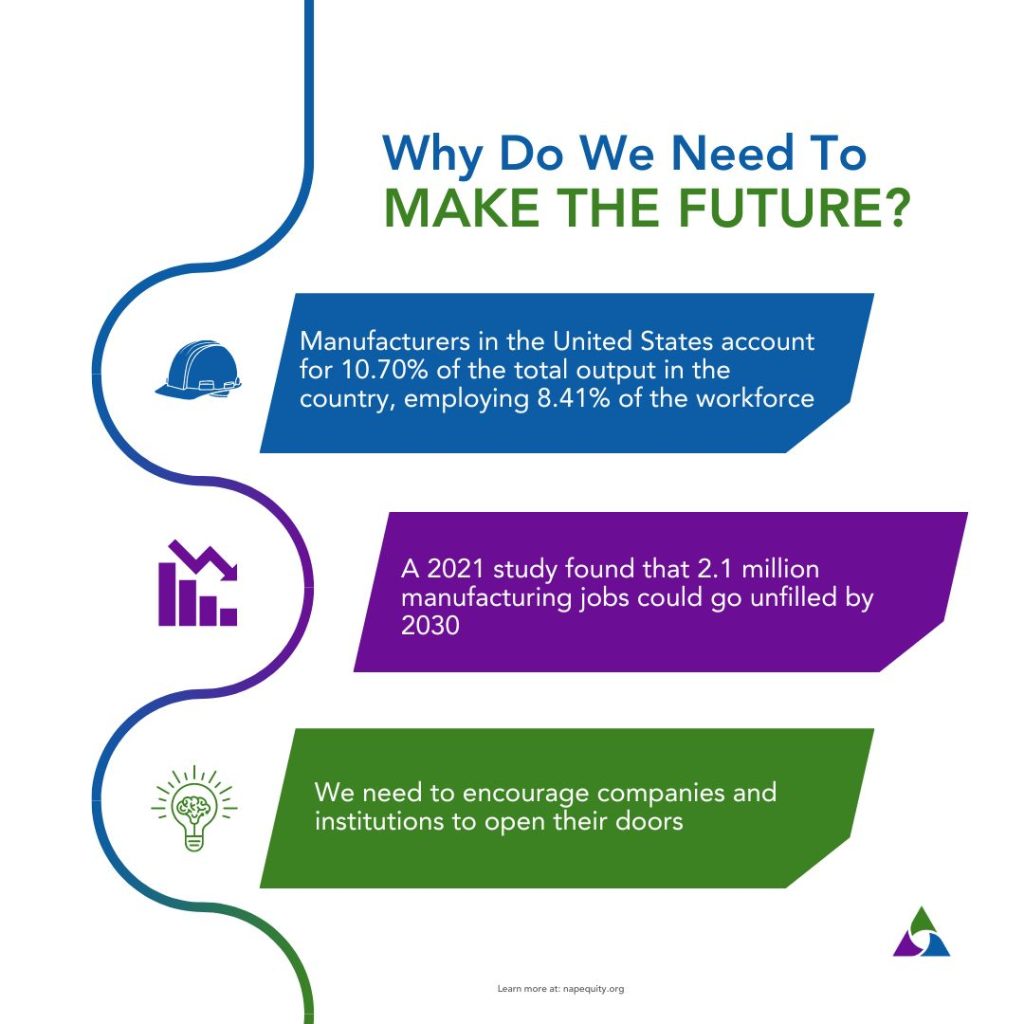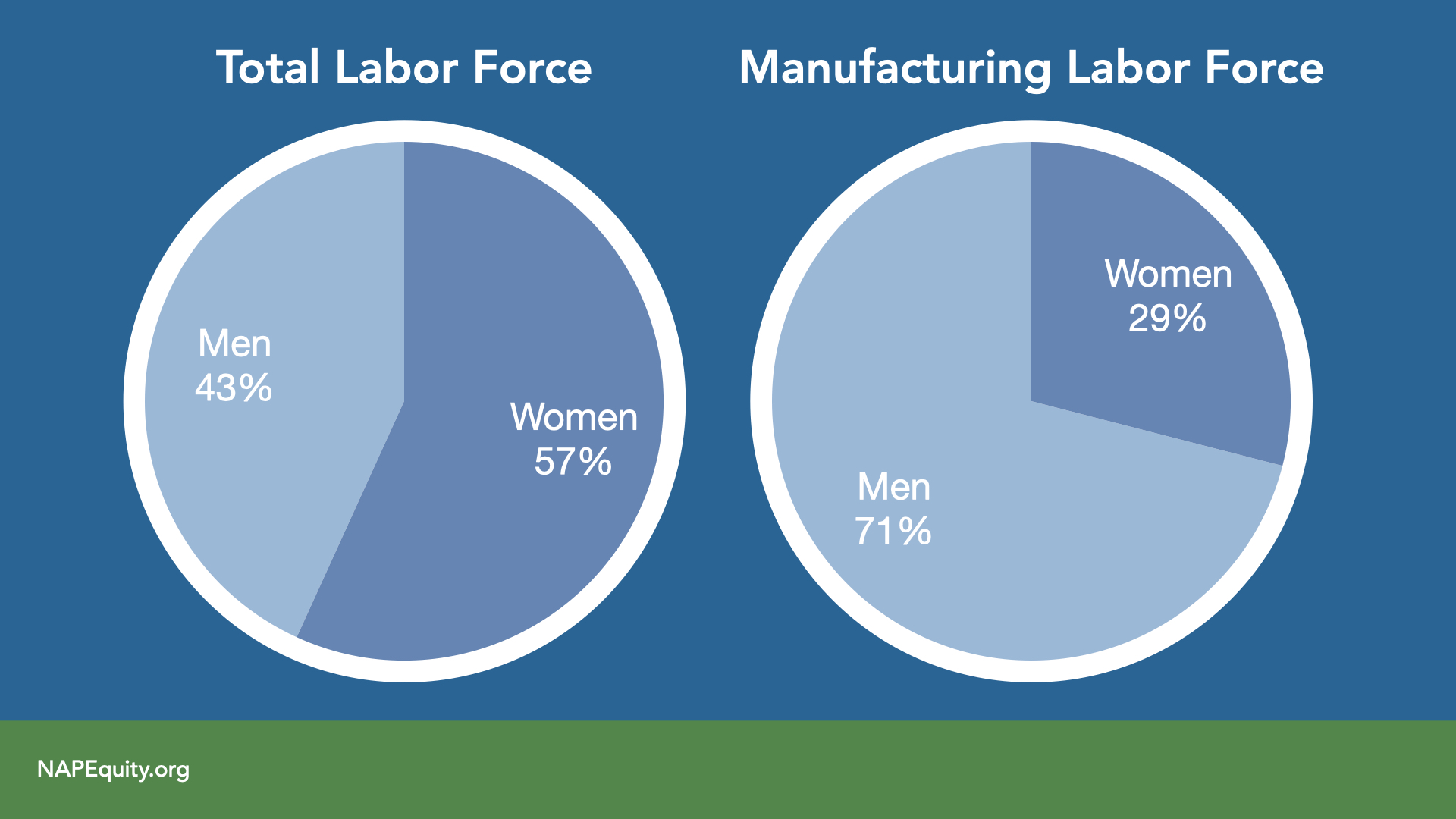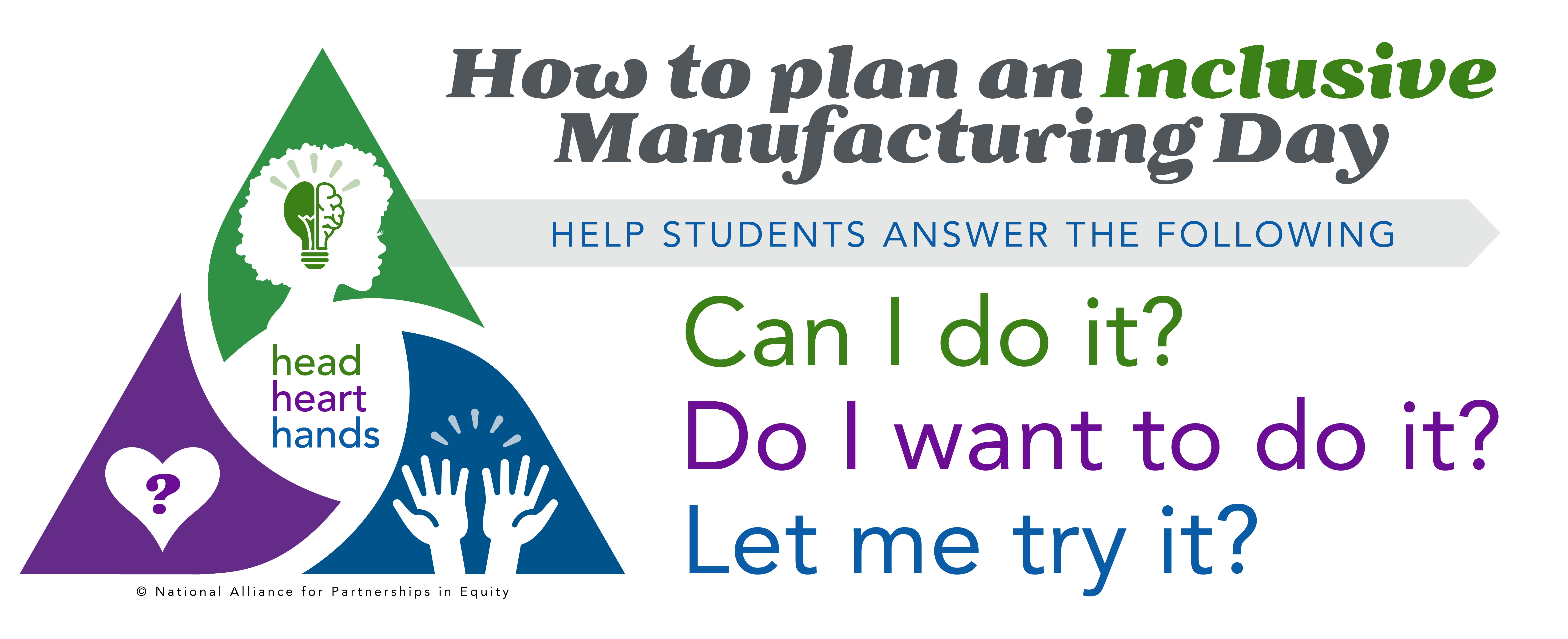In this post, we share research-based strategies for planning an inclusive manufacturing day. You’ll also find a webinar and a download that includes a 1-page summary of this post and a 3-page rubric to help you apply the strategies for an equitable and inclusive MFG day environment.
Rather watch or listen than read?
Check out this 15-minute overview webinar on How to Plan an Inclusive Manufacturing Day.

The objective is to encourage companies and institutions to open their doors to the community to build excitement about manufacturing careers. As of a 2022 report, manufacturers in the United States account for 10.70% of the total output in the country, employing 8.41% of the workforce (source). However, a 2021 study found that 2.1 million manufacturing jobs could go unfilled by 2030 (source).
Despite the demand and opportunity, women, Black, Hispanic, and Indigenous people disproportionately enter into and persist within the manufacturing industries. For the nation as a whole, the labor force participation rate for women was 56.8 percent in 2022 (source). In the manufacturing industry, women of color comprise 19.8% of the labor force compared to 6.1% of white women (source). The research is clear. There are numerous root causes (such as the ones described in this post) to explain the systematic exclusion and disparities of traditionally marginalized populations in Career and Technical Education (CTE) and Science, Technology, Engineering, and Mathematics (STEM) (source), and ultimately in manufacturing.


With MFG Day meant to excite the local communities about careers, we hope you want to excite EVERYONE! In this article, we focus on students, so to excite every kind of student, we must thoughtfully design an experience that is inclusive and connects to students’ heads, hearts, and hands. As you design your day, consider the following research-based prompts to encourage students imagine the possibilities for a future in manufacturing.


Self-efficacy answers the question, “Can I do this?” It is the belief that one can accomplish a specific task. Studies have found that self-efficacy is one of the most influential sources to choosing a career in STEM for girls (source). It might be easy to problematize students for lack of self-efficacy, but external factors deeply influence self-efficacy. Students from traditionally marginalized and excluded populations often have low self-efficacy regarding careers in CTE or STEM becaus of internalized oppressions (ideologies, interpersonal, and institutional policies and practices) that reinforce exclusion and discourage participation. There are four primary sources of self-efficacy: mastery experiences, vicarious experiences, social persuasion, and physiological cues, and the following strategies help to address the first three sources.
Super boost your events to build self-efficacy and show students they can do it! Here’s how:

The manufacturing industry is challenged to help students and the general public understand what manufacturing is and what manufacturers do. A stubborn mentality that manufacturing is not “for everyone,” perhaps especially not for those who do not fit the standard mold or align with stale stereotypes complicates the challenge. Plus, current perceptions and messages imply that manufacturing is dirty, dangerous, and demeaning – but this is not true.
To motivate students to pursue manufacturing and persist through challenges, we must start with an inspiring hook, or as Simon Sinek says, “start with why.” Ultimately, the messaging matters! To sustain the U.S. capacity for technological innovation and attract young people to careers in engineering, the National Academy of Engineering (NAE) commissioned a study to identify and test the ability of positive messages about engineering to improve the public’s understanding of it. The study found that we must re-brand engineers to appeal to different audiences, especially teenage girls.
Therefore, when we talk to students about manufacturing careers, we must use positive messaging to guide our conversations to increase students’ awareness of opportunities and spark their interest in manufacturing careers. The messages below are a modified version of the NAE study results, customized to describe manufacturing professionals and manufacturing careers.
Through concerted efforts to expose students to careers in manufacturing using attractive and appealing terminology, we can diminish negative perceptions of manufacturing.
Start with why! Focus on key messages that help students see the impact and importance of manufacturing on their lives. Wherever possible, use appealing messaging that helps students see why a career in manufacturing is meaningful and rewarding and starkly different than common perceptions and stereotypes. Help them visualize potential pathways to a career in manufacturing and what their life might look like as a manufacturer.

Studies show that traditionally marginalized and excluded students who participate in project or problem-based learning (PBL) are more likely to succeed in these programs of study and potentially follow career paths in these fields. Key components of equity-focused PBL have the potential to help disrupt a cycle of inequity that often leads to marginalization and exclusion, and those are 1) promote student-centered learning, 2) cultivate an equitable team-learning environment, and 2) create authentic, relevant learning contexts. When planning your manufacturing day events or activities, you want to incorporate elements of PBL into your design. That means simple tours, worksheets, or meaningless arts and crafts style activities are NOT ideal for appealing to students and getting them excited about manufacturing. You want to design activities that are accessible, relatable, and deeply engaging.
Encourage learning that revolves around students, not just the subject or the teacher. How? By sparking students’ curiosity, giving them options to choose from, and providing the right support as they learn. This way, students take charge of their learning journey, making it more engaging and effective. Student-Centered Learning creates more equitable learning environments compared to content-driven learning, because it allows students and instructors to adapt the learning to each student, resulting in an environment that is motivational, allows for greater intellectual development, and attracts a wider variety of students into a field. There are two key things to remember:
Facilitate equitable team-learning environments: this doesn’t happen without intentional effort, planning, and monitoring. When possible, ensure student groups are demographically representative of their community and design activities that allow students to work together with relatable professionals towards a shared goal. It is also important that you and your volunteers actively work to reduce the ways in which gender and racial stereotypes play out in the learning environment.
Create authentic, hands-on, real-world learning activities that highlight social impact and also relate to the student’s lived experiences. Activities that are situated in an unfamiliar context for students will not be motivational, but activities that stem from the student’s own culture, identity, and lived experiences will be engaging. For example, back in 2008 I presented 3 workshops entitled “How to fit a Ham Sandwich in your Ipod” for 4-5th grade girls at the Sally Ride Science Festival in Dallas. This was an interactive lesson where participants learned about how engineers make transistors, what transistors have done for technology, and how those transistors relate to their lives – such as make the then popular Ipods work. Girls learned about different kinds of engineers and the manufacturing process by working in teams to build a transistor using components of a ham sandwich. This was a modification of a previous lesson that just taught students how to build a transistor, without enough context to how it related to their lives.
Finally, manufacturing is more than widgets, gadgets, and assembly lines. It is also important to connect what you are doing in your activities to professional skills (formerly called “soft” skills) they are already learning in school, like communication, collaboration, and teamwork.

As you plan for your manufacturing day events for students, remember the research-based prompts to help students imagine the possibilities for a future in manufacturing:
Can I do it? Do I want to do it? Let me do it?
Follow the strategies outlined in this resource to help you make your day one that students will never forget.
with a 1-page summary of this post and a 3-page rubric to help you apply the strategies for an equitable and inclusive environment.

Watch this 2-minute introduction the the rubric tool